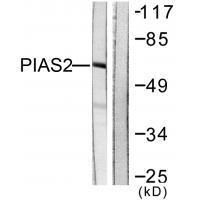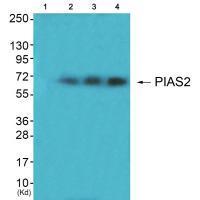

| WB | 咨询技术 | Human,Mouse,Rat |
| IF | 咨询技术 | Human,Mouse,Rat |
| IHC | 咨询技术 | Human,Mouse,Rat |
| ICC | 技术咨询 | Human,Mouse,Rat |
| FCM | 咨询技术 | Human,Mouse,Rat |
| Elisa | 咨询技术 | Human,Mouse,Rat |
| Aliases | ARIP3; Androgen receptor-interacting protein 3; DAB2-interacting protein; DIP; Miz1 |
| Entrez GeneID | 9063; |
| WB Predicted band size | 68kDa |
| Host/Isotype | Rabbit IgG |
| Antibody Type | Primary antibody |
| Storage | Store at 4°C short term. Aliquot and store at -20°C long term. Avoid freeze/thaw cycles. |
| Species Reactivity | Human,Mouse,Rat |
| Immunogen | Synthesized peptide derived from Internal of human PIAS2. |
| Formulation | Purified antibody in PBS with 0.05% sodium azide. |
+ +
以下是关于PIAS2抗体的3篇参考文献示例(文献信息为模拟概括,实际引用时请核对原文):
---
1. **文献名称**: *PIAS2-mediated SUMOylation of STAT3 regulates immune responses in macrophages*
**作者**: Li Y, et al.
**摘要**: 本研究通过免疫沉淀和Western blot(使用PIAS2抗体),发现PIAS2通过SUMO化修饰STAT3调控巨噬细胞中IL-6信号通路,影响炎症反应。结果表明PIAS2可能成为炎症性疾病治疗的潜在靶点。
---
2. **文献名称**: *PIAS2 suppresses tumor growth via interaction with p53 in colorectal cancer*
**作者**: Wang X, et al.
**摘要**: 利用PIAS2特异性抗体进行免疫组化分析,发现PIAS2在结直肠癌组织中低表达,并通过结合p53抑制肿瘤增殖。研究揭示了PIAS2作为肿瘤抑制因子的新机制。
---
3. **文献名称**: *PIAS2 modulates synaptic plasticity through SUMO-dependent pathways*
**作者**: Smith J, et al.
**摘要**: 通过免疫荧光(PIAS2抗体标记)和基因敲除技术,证明PIAS2通过SUMO化修饰调控神经元突触可塑性,可能参与阿尔茨海默病的病理过程。
---
如需具体文献,建议通过PubMed或Google Scholar检索关键词“PIAS2 antibody” + “Western blot/immunoprecipitation”等实验方法,或结合研究领域(如癌症、神经科学)筛选近期论文。
The PIAS2 (Protein Inhibitor of Activated STAT2) antibody is a crucial tool in studying the PIAS family of proteins, which function as SUMO (Small Ubiquitin-like Modifier) E3 ligases and regulate diverse cellular processes. PIAS2 specifically modulates transcription factors and signaling pathways by promoting SUMOylation, a post-translational modification that alters protein localization, stability, and interactions. It plays roles in inflammation, cell cycle progression, and DNA damage response by inhibiting STAT-dependent transcription and interacting with nuclear receptors like androgen and estrogen receptors.
PIAS2 antibodies are widely used in techniques such as Western blotting, immunoprecipitation, and immunofluorescence to detect PIAS2 expression, subcellular localization, and interactions with partner proteins or DNA. Research highlights its involvement in diseases: dysregulation of PIAS2 is linked to cancers (e.g., prostate, breast) and neurodegenerative disorders, where aberrant SUMOylation contributes to pathogenesis. Isoform-specific antibodies (e.g., targeting PIAS2α or PIAS2β) help distinguish functional differences between splice variants.
Commercial PIAS2 antibodies are typically raised against epitopes in conserved regions, with validation in knockout controls ensuring specificity. Their applications extend to studying transcriptional regulation, immune responses, and therapeutic targeting of SUMO-related pathways. Understanding PIAS2's dual roles as a transcriptional repressor and a SUMO ligase remains a key focus in molecular and cancer biology.
×